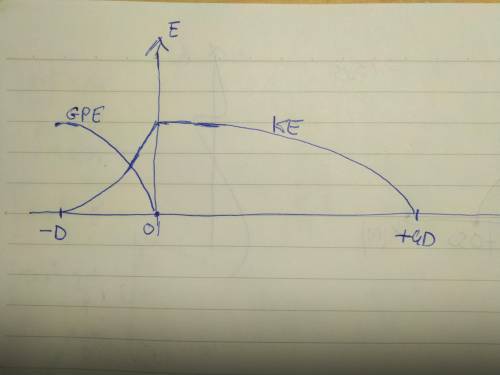
Physics, 22.04.2020 16:51 saintsfan2004
A block is initially at rest on top of an inclined ramp that makes an angle θ0 with the horizontal. The base of the ramp has a length of D . After the block is released from rest, it slides down the ramp onto a rough horizontal surface until it comes to rest at a position x=4D from the base of the ramp, as shown in the figure. There is negligible friction between the block and the inclined ramp, while the coefficient of kinetic friction between the block and the rough horizontal surface is μb .
(a) On the axes below, sketch and label graphs of the following quantities as a function of the position of the block between x=−D and x=4D . Calculations for values for the vertical axis are not necessary, but the same vertical scale should be used for both quantities.
i. The kinetic energy K of the block
ii. The gravitational potential energy Ug of the block-Earth system
(b) The block is released from the top of a new ramp that has a base length of 2D, but still makes an angle θ0 with the horizontal. A student is asked to predict whether the final horizontal position of the block will be twice as far from the base of the ramp compared to when it was released from the original ramp. The student reasons that since the block will be released from a new height that is twice as high as the original height, the block will have more energy when it reaches the base of the ramp, so it will slide farther along the right surface before stopping at a position x=8D.
i. Which aspects of the student’s reasoning, if any, are correct? If no aspect of the student’s reasoning is correct, write “none”.
ii. Which aspects of the student’s reasoning, if any, are incorrect? If no aspect of the student’s reasoning is incorrect, write “none”.
(c) Derive an equation for the new final position of the block. Express your answer in terms of D.
(d) In the following question, refer to the relationships written in part (c), not just the final answer obtained by manipulating those relationships.
For any correct aspects of the student’s reasoning identified in part (b)(i), how is the student’s reasoning expressed by your mathematical relationships in part (c) ?
For any incorrect aspects of the student’s reasoning identified in part (b)(ii), how do your relationships in part (c) correct the student’s incorrect reasoning?

Answers: 1


Another question on Physics


Physics, 22.06.2019 08:00
Aheat engine running backward is called a refrigerator if its purpose is to extract heat from a cold reservoir. the same engine running backward is called a heat pump if its purpose is to exhaust warm air into the hot reservoir. heat pumps are widely used for home heating. you can think of a heat pump as a refrigerator that is cooling the already cold outdoors and, with its exhaust heat qh, warming the indoors. perhaps this seems a little silly, but consider the following. electricity can be directly used to heat a home by passing an electric current through a heating coil. this is a direct, 100% conversion of work to heat. that is, 19.0 \rm kw of electric power (generated by doing work at the rate 19.0 kj/s at the power plant) produces heat energy inside the home at a rate of 19.0 kj/s. suppose that the neighbor's home has a heat pump with a coefficient of performance of 4.00, a realistic value. note: with a refrigerator, "what you get" is heat removed. but with a heat pump, "what you get" is heat delivered. so the coefficient of performance of a heat pump is k=qh/win. an average price for electricity is about 40 mj per dollar. a furnace or heat pump will run typically 200 hours per month during the winter. what does one month's heating cost in the home with a 16.0 kw electric heater? what does one month's heating cost in the home of a neighbor who uses a heat pump to provide the same amount of heating?
Answers: 2

Physics, 22.06.2019 09:30
Acar traveling at 22 m/s starts to decelerate steadily. it comes to a complete stop in 15 seconds. what is it’s acceleration?
Answers: 1

Physics, 23.06.2019 03:50
In a star, nuclear fusion occurs in the a. photosphere. b. corona. c. radiative zone. d. core.
Answers: 2
You know the right answer?
A block is initially at rest on top of an inclined ramp that makes an angle θ0 with the horizontal....
Questions

Mathematics, 29.04.2021 17:40


Social Studies, 29.04.2021 17:40

Mathematics, 29.04.2021 17:40

Advanced Placement (AP), 29.04.2021 17:40


Mathematics, 29.04.2021 17:40



Biology, 29.04.2021 17:40


Mathematics, 29.04.2021 17:40




History, 29.04.2021 17:40




History, 29.04.2021 17:40







 the initial total energy of the block at the top of the ramp.
the initial total energy of the block at the top of the ramp.
 is the height of the ramp.
is the height of the ramp.


 is the final speed of the block
is the final speed of the block is the acceleration due to friction
is the acceleration due to friction (1)
(1)
 in part a) and
in part a) and  in part b)
in part b)



